2007 ISUZU KB P190 bulb
[x] Cancel search: bulbPage 5286 of 6020
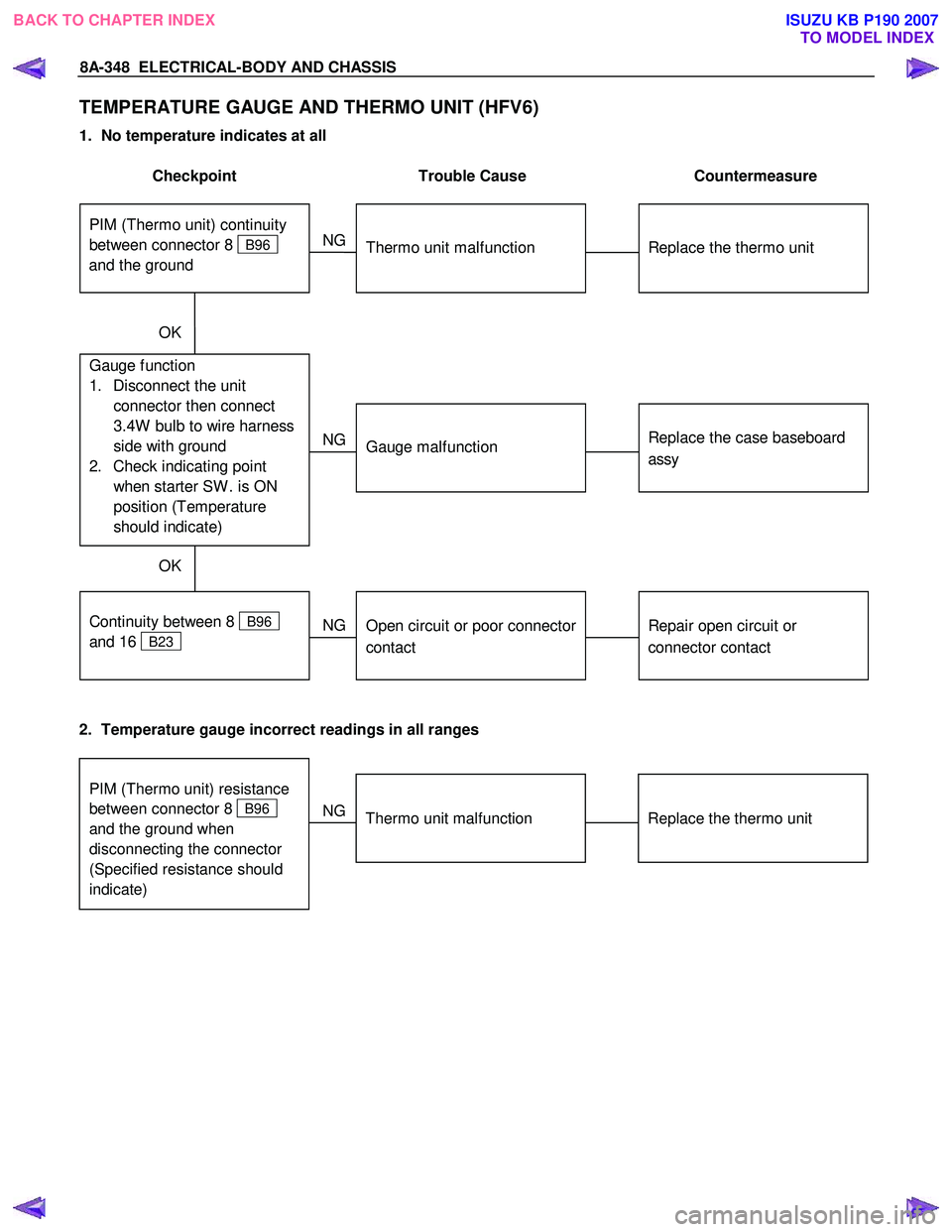
8A-348 ELECTRICAL-BODY AND CHASSIS
TEMPERATURE GAUGE AND THERMO UNIT (HFV6)
1. No temperature indicates at all
Checkpoint Trouble Cause Countermeasure
Replace the thermo unit
Thermo unit malfunction
NG
Replace the case baseboard
assy
Gauge function
1. Disconnect the unit connector then connect
3.4W bulb to wire harness
side with ground
2. Check indicating point when starter SW . is ON
position (Temperature
should indicate)
Gauge malfunction
Repair open circuit or
connector contact
Continuity between 8 B96
and 16
B23
Open circuit or poor connector
contact
NG
NG
OK
OK
PIM (Thermo unit) continuity
between connector 8
B96
and the ground
2. Temperature gauge incorrect readings in all ranges
Replace the thermo unit
Thermo unit malfunction
NG
PIM (Thermo unit) resistance
between connector 8
B96
and the ground when
disconnecting the connector
(Specified resistance should
indicate)
BACK TO CHAPTER INDEX TO MODEL INDEXISUZU KB P190 2007
Page 5287 of 6020
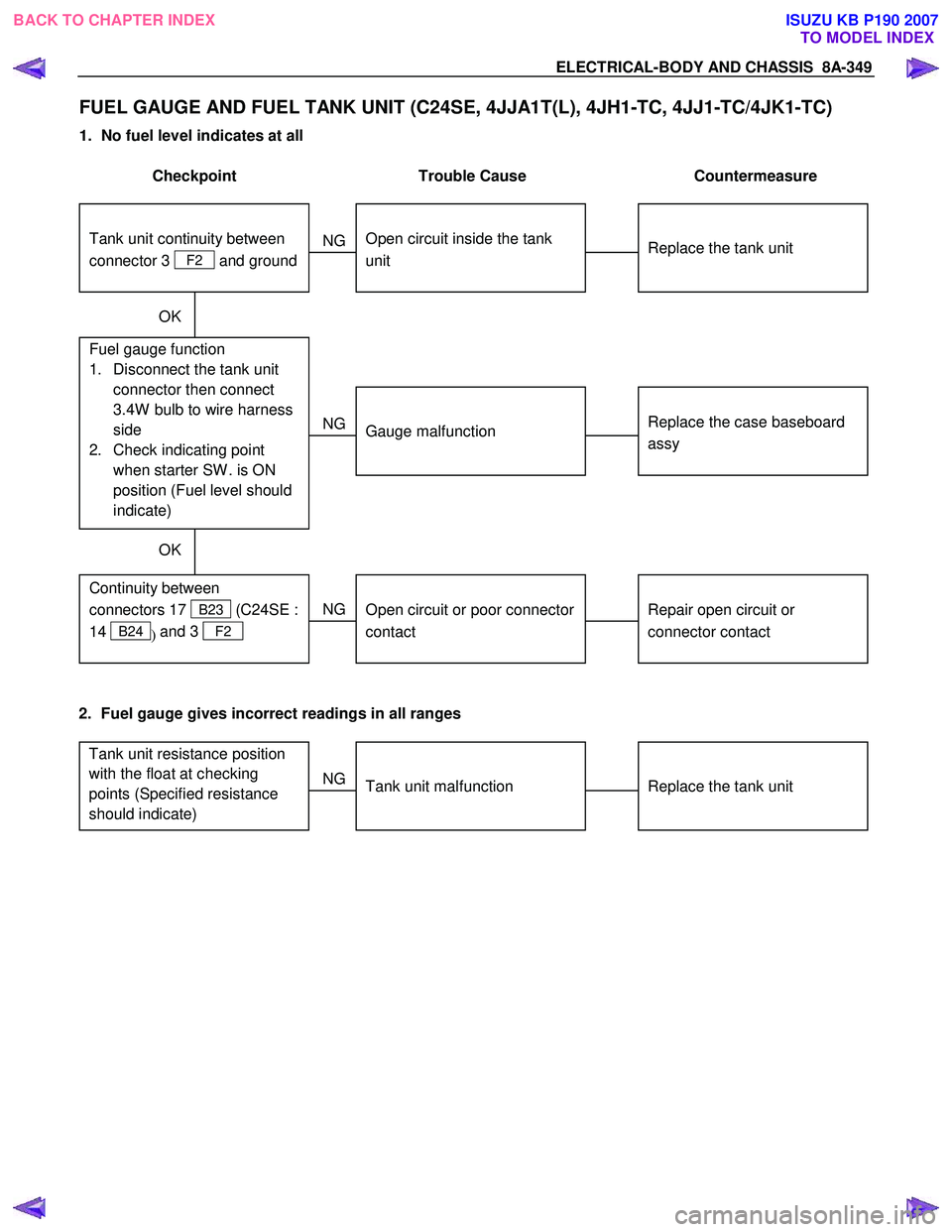
ELECTRICAL-BODY AND CHASSIS 8A-349
FUEL GAUGE AND FUEL TANK UNIT (C24SE, 4JJA1T(L), 4JH1-TC, 4JJ1-TC/4JK1-TC)
1. No fuel level indicates at all
Checkpoint Trouble Cause Countermeasure
Replace the tank unit
Open circuit inside the tank
unit
NG
Thermo unit malfunction
Replace the case baseboard
assy
Fuel gauge function
1. Disconnect the tank unit connector then connect
3.4W bulb to wire harness
side
2. Check indicating point when starter SW . is ON
position (Fuel level should
indicate)
Gauge malfunction
Repair open circuit or
connector contact
Continuity between
connectors 17
B23 (C24SE :
14
B24 ) and 3
F2
Open circuit or poor connector
contact
NG
NG
OK
OK
Tank unit continuity between
connector 3
F2 and ground
2. Fuel gauge gives incorrect readings in all ranges
Replace the tank unitTank unit malfunction
NG
Tank unit resistance position
with the float at checking
points (Specified resistance
should indicate)
BACK TO CHAPTER INDEX
TO MODEL INDEXISUZU KB P190 2007
Page 5288 of 6020
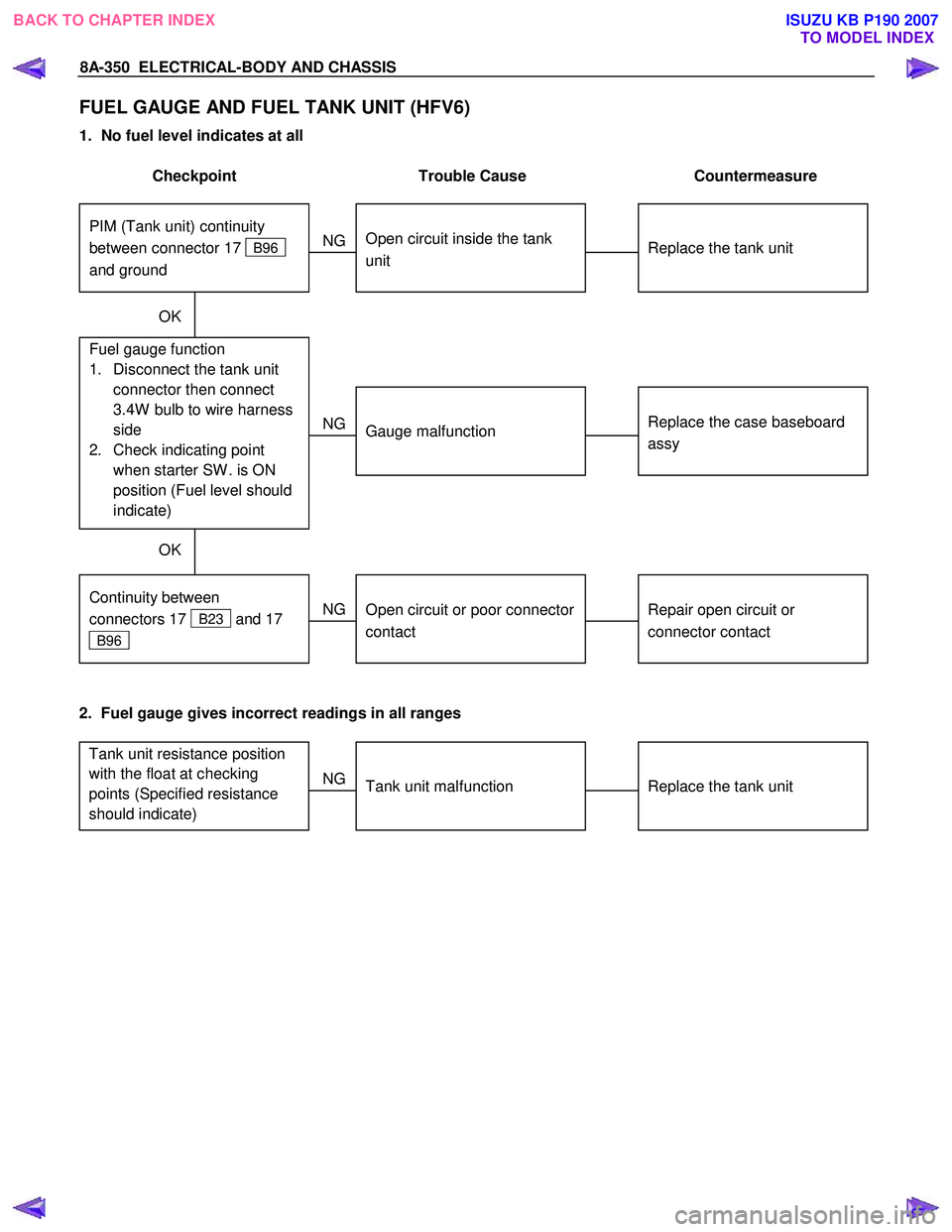
8A-350 ELECTRICAL-BODY AND CHASSIS
FUEL GAUGE AND FUEL TANK UNIT (HFV6)
1. No fuel level indicates at all
Checkpoint Trouble Cause Countermeasure
Replace the tank unit
Open circuit inside the tank
unit
NG
Thermo unit malfunction
Replace the case baseboard
assy
Fuel gauge function
1. Disconnect the tank unit connector then connect
3.4W bulb to wire harness
side
2. Check indicating point when starter SW . is ON
position (Fuel level should
indicate)
Gauge malfunction
Repair open circuit or
connector contact
Continuity between
connectors 17
B23 and 17
B96
Open circuit or poor connector
contact
NG
NG
OK
OK
PIM (Tank unit) continuity
between connector 17
B96
and ground
2. Fuel gauge gives incorrect readings in all ranges
Replace the tank unitTank unit malfunction
NG
Tank unit resistance position
with the float at checking
points (Specified resistance
should indicate)
BACK TO CHAPTER INDEX TO MODEL INDEXISUZU KB P190 2007
Page 5289 of 6020
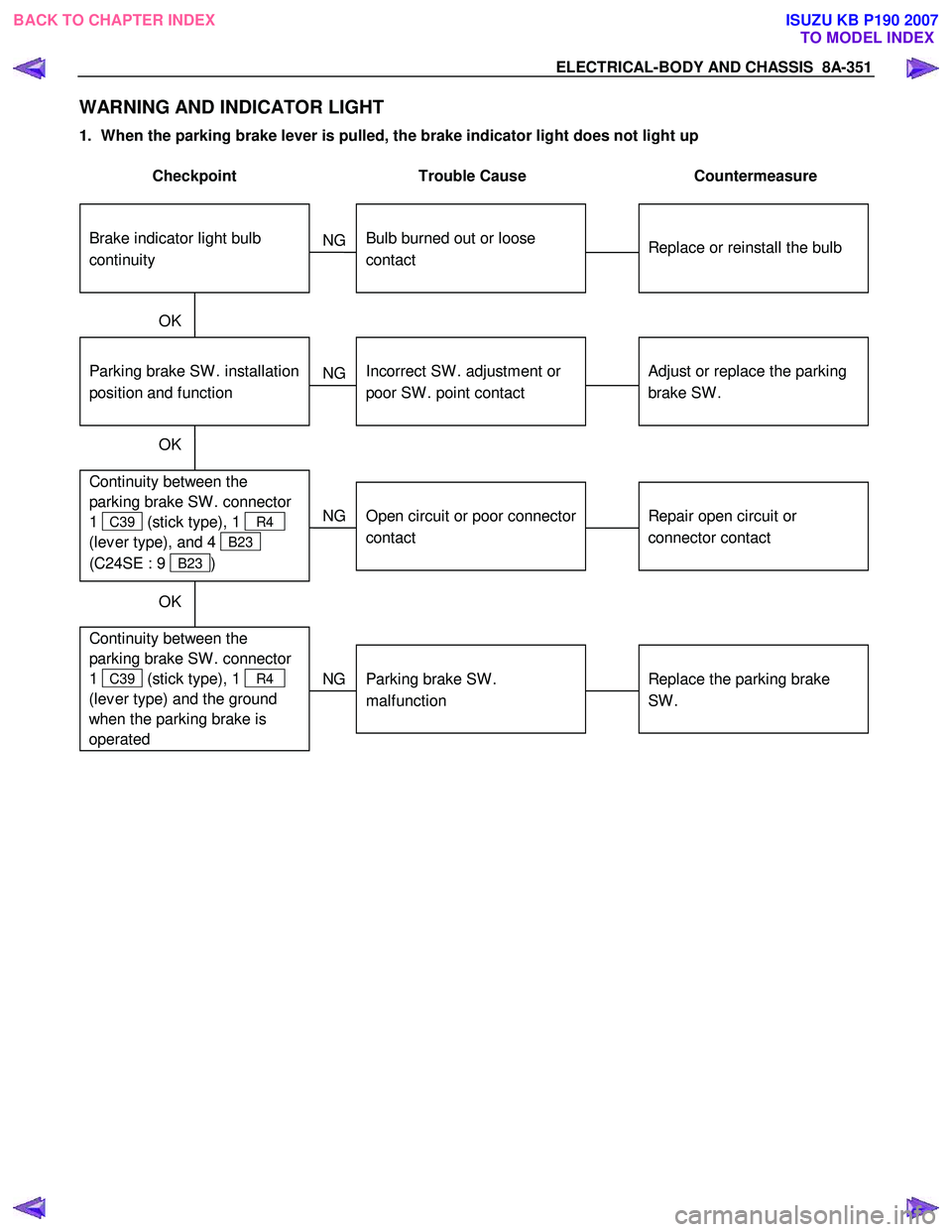
ELECTRICAL-BODY AND CHASSIS 8A-351
WARNING AND INDICATOR LIGHT
1. When the parking brake lever is pulled, the brake indicator light does not light up
Checkpoint Trouble Cause Countermeasure
Replace or reinstall the bulb
Bulb burned out or loose
contact
NG
Adjust or replace the parking
brake SW .
Parking brake SW . installation
position and function
Incorrect SW . adjustment or
poor SW . point contact
Continuity between the
parking brake SW . connector
1
C39 (stick type), 1 R4
(lev er type), and 4
B23
(C24SE : 9
B23 )
Repair open circuit or
connector contact
Open circuit or poor connector
contact
NG
NG
OK
OK
Brake indicator light bulb
continuity
NG
OK
Continuity between the
parking brake SW . connector
1
C39 (stick type), 1 R4
(lev er type) and the ground
when the parking brake is
operated
Replace the parking brake
SW .
Parking brake SW .
malfunction
BACK TO CHAPTER INDEX TO MODEL INDEXISUZU KB P190 2007
Page 5307 of 6020
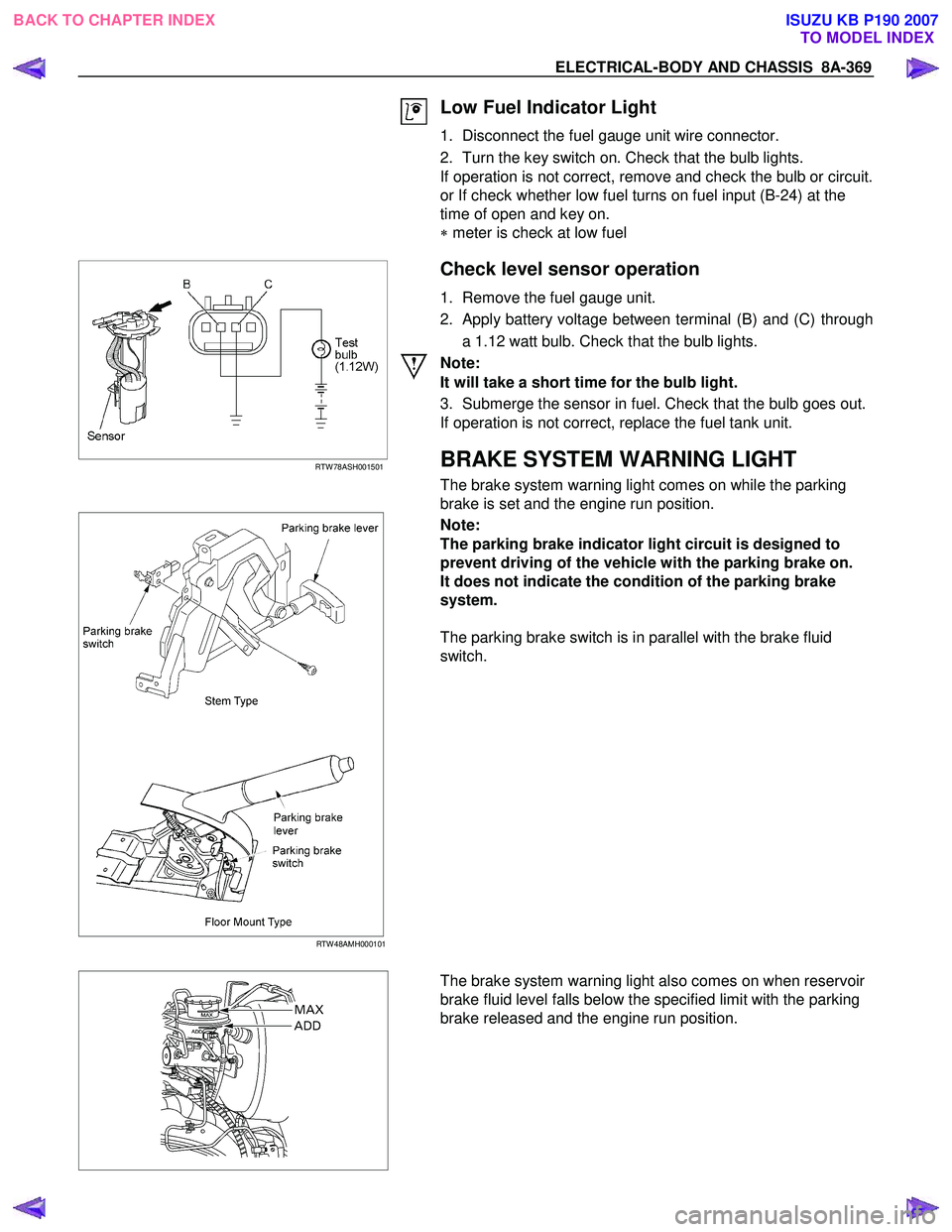
ELECTRICAL-BODY AND CHASSIS 8A-369
Low Fuel Indicator Light
1. Disconnect the fuel gauge unit wire connector.
2. Turn the key switch on. Check that the bulb lights.
If operation is not correct, remove and check the bulb or circuit.
or If check whether low fuel turns on fuel input (B-24) at the
time of open and key on.
∗ meter is check at low fuel
RTW 78ASH001501
Check level sensor operation
1. Remove the fuel gauge unit.
2. Apply battery voltage between terminal (B) and (C) through a 1.12 watt bulb. Check that the bulb lights.
Note:
It will take a short time for the bulb light.
3. Submerge the sensor in fuel. Check that the bulb goes out.
If operation is not correct, replace the fuel tank unit.
BRAKE SYSTEM WARNING LIGHT
The brake system warning light comes on while the parking
brake is set and the engine run position.
RTW 48AMH000101
Note:
The parking brake indicator light circuit is designed to
prevent driving of the vehicle with the parking brake on.
It does not indicate the condition of the parking brake
system.
The parking brake switch is in parallel with the brake fluid
switch.
The brake system warning light also comes on when reservoir
brake fluid level falls below the specified limit with the parking
brake released and the engine run position.
BACK TO CHAPTER INDEX TO MODEL INDEXISUZU KB P190 2007
Page 5651 of 6020
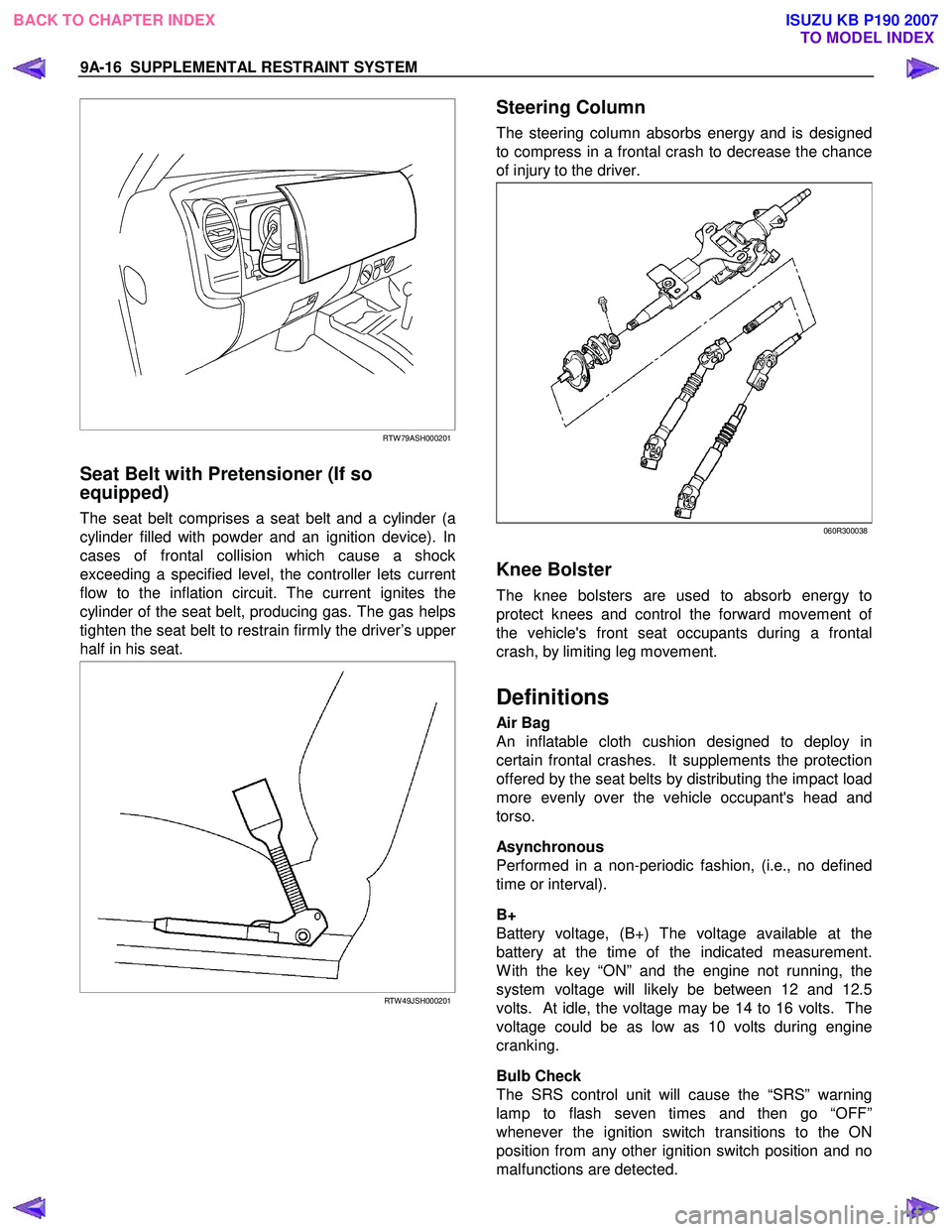
9A-16 SUPPLEMENTAL RESTRAINT SYSTEM
RTW 79ASH000201
Seat Belt with Pretensioner (If so
equipped)
The seat belt comprises a seat belt and a cylinder (a
cylinder filled with powder and an ignition device). In
cases of frontal collision which cause a shock
exceeding a specified level, the controller lets current
flow to the inflation circuit. The current ignites the
cylinder of the seat belt, producing gas. The gas helps
tighten the seat belt to restrain firmly the driver’s uppe
r
half in his seat.
RTW 49JSH000201
Steering Column
The steering column absorbs energy and is designed
to compress in a frontal crash to decrease the chance
of injury to the driver.
060R300038
Knee Bolster
The knee bolsters are used to absorb energy to
protect knees and control the forward movement o
f
the vehicle's front seat occupants during a frontal
crash, by limiting leg movement.
Definitions
Air Bag
An inflatable cloth cushion designed to deploy in
certain frontal crashes. It supplements the protection
offered by the seat belts by distributing the impact load
more evenly over the vehicle occupant's head and
torso.
Asynchronous
Performed in a non-periodic fashion, (i.e., no defined
time or interval).
B+
Battery voltage, (B+) The voltage available at the
battery at the time of the indicated measurement.
W ith the key “ON” and the engine not running, the
system voltage will likely be between 12 and 12.5
volts. At idle, the voltage may be 14 to 16 volts. The
voltage could be as low as 10 volts during engine
cranking.
Bulb Check
The SRS control unit will cause the “SRS” warning
lamp to flash seven times and then go “OFF”
whenever the ignition switch transitions to the ON
position from any other ignition switch position and no
malfunctions are detected.
BACK TO CHAPTER INDEX TO MODEL INDEXISUZU KB P190 2007
Page 5697 of 6020
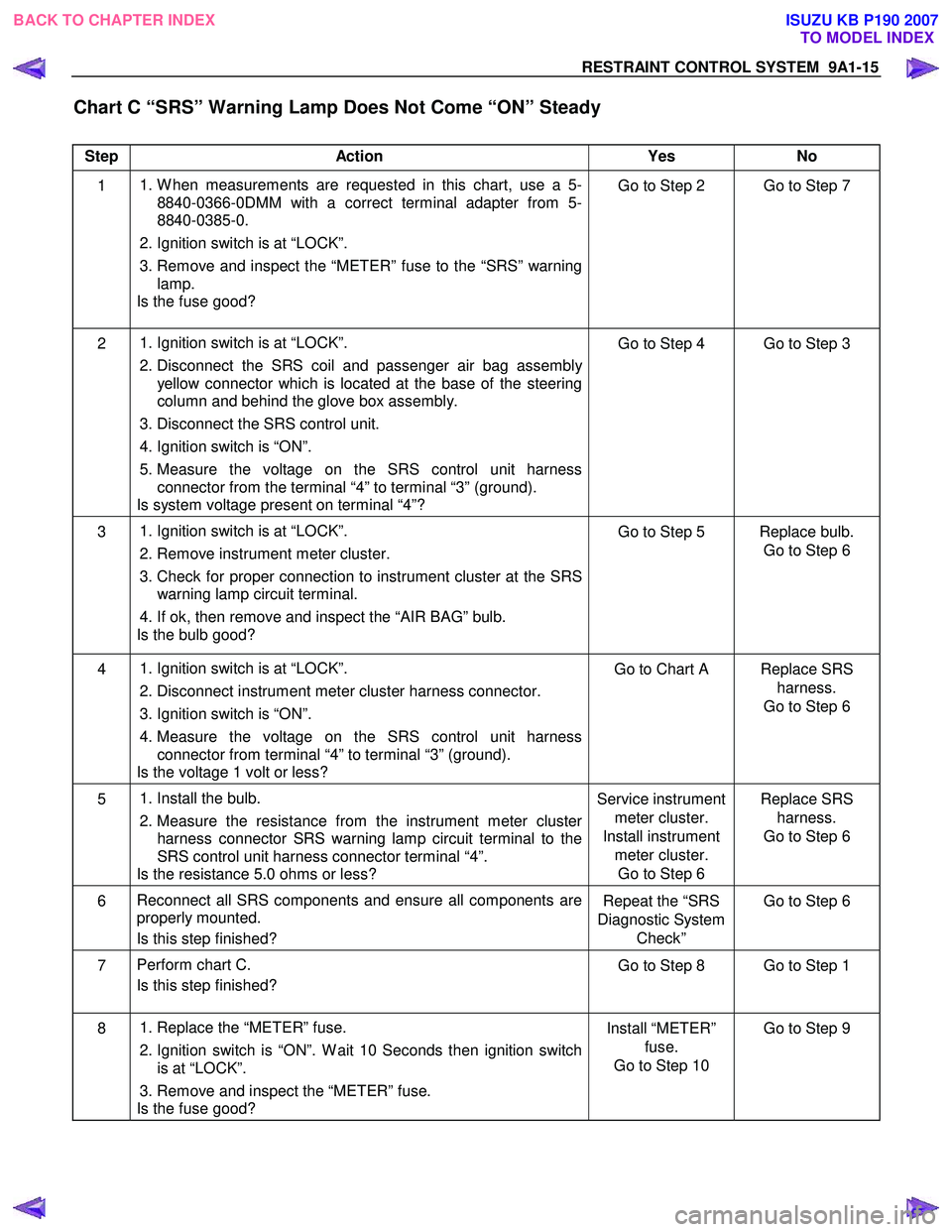
RESTRAINT CONTROL SYSTEM 9A1-15
Chart C “SRS” Warning Lamp Does Not Come “ON” Steady
Step Action Yes No
1
1. W hen measurements are requested in this chart, use a 5-
8840-0366-0DMM with a correct terminal adapter from 5-
8840-0385-0.
2. Ignition switch is at “LOCK”.
3. Remove and inspect the “METER” fuse to the “SRS” warning lamp.
Is the fuse good? Go to Step 2 Go to Step 7
2
1. Ignition switch is at “LOCK”.
2. Disconnect the SRS coil and passenger air bag assembly
yellow connector which is located at the base of the steering
column and behind the glove box assembly.
3. Disconnect the SRS control unit.
4. Ignition switch is “ON”.
5. Measure the voltage on the SRS control unit harness connector from the terminal “4” to terminal “3” (ground).
Is system voltage present on terminal “4”? Go to Step 4 Go to Step 3
3
1. Ignition switch is at “LOCK”.
2. Remove instrument meter cluster.
3. Check for proper connection to instrument cluster at the SRS warning lamp circuit terminal.
4. If ok, then remove and inspect the “AIR BAG” bulb.
Is the bulb good? Go to Step 5 Replace bulb.
Go to Step 6
4
1. Ignition switch is at “LOCK”.
2. Disconnect instrument meter cluster harness connector.
3. Ignition switch is “ON”.
4. Measure the voltage on the SRS control unit harness
connector from terminal “4” to terminal “3” (ground).
Is the voltage 1 volt or less? Go to Chart A Replace SRS
harness.
Go to Step 6
5
1. Install the bulb.
2. Measure the resistance from the instrument meter cluster
harness connector SRS warning lamp circuit terminal to the
SRS control unit harness connector terminal “4”.
Is the resistance 5.0 ohms or less? Service instrument
meter cluster.
Install instrument meter cluster. Go to Step 6 Replace SRS
harness.
Go to Step 6
6 Reconnect all SRS components and ensure all components are
properly mounted.
Is this step finished? Repeat the “SRS
Diagnostic System Check” Go to Step 6
7
Perform chart C.
Is this step finished? Go to Step 8 Go to Step 1
8
1. Replace the “METER” fuse.
2. Ignition switch is “ON”. W ait 10 Seconds then ignition switch
is at “LOCK”.
3. Remove and inspect the “METER” fuse.
Is the fuse good? Install “METER”
fuse.
Go to Step 10 Go to Step 9
BACK TO CHAPTER INDEX
TO MODEL INDEX
ISUZU KB P190 2007
Page 5700 of 6020

9A1-18 RESTRAINT CONTROL SYSTEM
DTC Will Clear When
Resistance value returns specified resistance value.
DTC Chart Test Description
Number(s) below refer to step number(s) on the
diagnostic chart:
2. This test determines whether the malfunction is in
the SRS control unit.
3. This test verifies proper connection of the yello
w
connector.
4. This test checks for proper contact and/or corrosion
of the yellow connector terminals.
5. This test checks for a malfunctioning passenger ai
r
bag assembly.
6. This test determines whether the malfunction is due
to a high resistance in the wiring.
Diagnostic Aids
An intermittent condition is likely to be caused by a poor
connection at the passenger air bag assembly harness
connector terminals “1” and “2”, SRS control unit
terminal “17” and “16”, or a poor wire to terminal
connection in circuits “Passenger Bag High” and
“Passenger Bag Low”. The test for this diagnostic
trouble code is only run while the “SRS” warning lamp is
performing the bulb check. W hen the scan tool “Clea
r
Codes” command is issued and the malfunction is still
present, the DTC will not reappear until the next ignition
cycle.
DTC B0015 (Flash Code 15) Passenger Air Bag Squib Circuit High Resistance
Step Action Yes No
1 W as the “SRS Diagnostic System Check” Performed?
Go to Step 2 Go to The “SRS
Diagnostic System Check”
2
1. Check the passenger air bag squib circuit for open.
2. If a problem is found, repair as necessary.
W as a problem found? Verify repair Go to Step 3
3
1. Ignition switch is at “LOCK”.
2. Make sure the passenger air bag assembly yellow connector
located behind the glove box assembly is seated properly.
Is the yellow connector connected properly? Go to Step 4 Seat passenger Air
Bag assembly
yellow connector properly.
Go to Step 7
4
1. Disconnect and inspect the passenger air bag assembly
yellow connector located behind the glove box assembly.
2. If OK, reconnect the passenger air bag assembly connector.
3. Ignition switch is “ON”.
Is DTC B0015 current? Go to Step 5 Go to Step 7
5
1. Ignition switch is at “LOCK”.
2. Disconnect the SRS coil and passenger air bag assembly,
yellow connector located at the base of the steering column
and behind the glove box assembly.
3. Connect a 5-8840-2421-0 SRS driver / passenger load tool
and appropriate adapters to the SRS coil and passenger air
bag assembly harness connectors.
4. Ignition switch is “ON”.
Is DTC B0015 Current? Go to Step 6 Ignition switch
“LOCK”.
Replace the
passenger air bag assembly.
Go to Step 7
BACK TO CHAPTER INDEX TO MODEL INDEX
ISUZU KB P190 2007